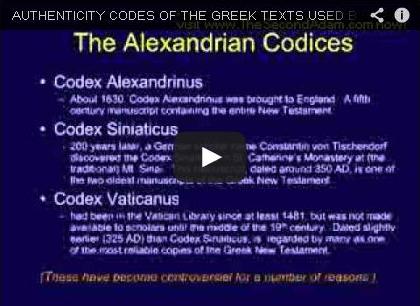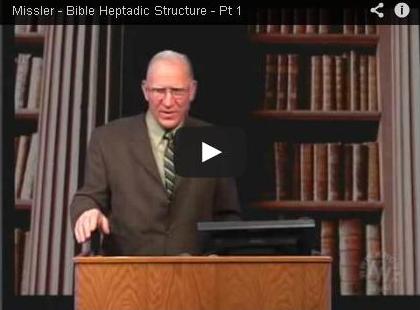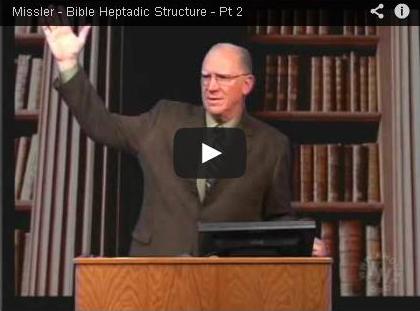– The Number Seven –
God’s Authenticator For The King James Version Bible
"The words of the LORD are pure words: as silver tried in a furnace of earth, purified seven times.
Thou shalt keep them, O LORD, thou shalt preserve them from this generation for ever."
(Psalms 12:6-7 KJV)
The numerical structure of the Holy Bible has been studied closely in the past, the subject of numerous volumes of writings. However, none are more provocative than the works of Dr. Ivan Panin (The Inspiration of the Scriptures Scientifically Demonstrated).
Ivan Panin was born in Russia on December 12, 1855. Having participated in plots against the Czar, he was exiled from his homeland at an early age. After studying in Germany for some years, he came to the United States and entered Harvard University. He graduated in 1882 and made the conversion from agnosticism to Christianity.
In 1890 he made the discovery of the phenomenal mathematical designs underlying both the Greek text of the New Testament and the Hebrew text of the Old Testament.
From that point on Ivan Panin devoted over 50 years of his life to exploring the numerical structure of the Scriptures, generating over 43,000 detailed hand-penned pages of analysis (and exhausting his health in the process).
Ivan Panin went on to be with the Lord in his 87th year, on October 30, 1942.
The Heptadic (#7) Structure
The recurrence of the number seven – or an exact multiple of seven – is found throughout the Holy Bible. The Sabbath on the seventh day; the seven years of plenty and the seven years of famine in Egypt; the seven priests and seven trumpets marching around Jericho; the Sabbath Year of the land. All are well-known examples of the number seven found in the Scriptures.
But let’s not neglect the seven years it took Solomon to build the Temple, and Naaman washing in the river seven times. And then the Book of Revelation has the seven churches, seven lamp stands, seven seals, seven trumpets, seven bowls, seven stars, and so on; all showing the consistent use of the number seven in God’s Word.
However, there is a much deeper meaning to the number seven as Ivan Panin discovered. There are amazing numerical properties hidden within the Biblical texts – both the New Testament Greek and the Old Testament Hebrew – that not only demonstrate an intricacy of design but also testifies to a supernatural origin!
Vocabulary
One of the simplest and most provocative aspects of the Biblical text is the vocabulary used to compose it. The number of vocabulary words in a passage is normally different from the total number of words in a passage: some words are repeated. It is easy, for example, to use a vocabulary of 500 words to write an essay of 4,000 words.
New Testament Example – Matthew 1:1-17
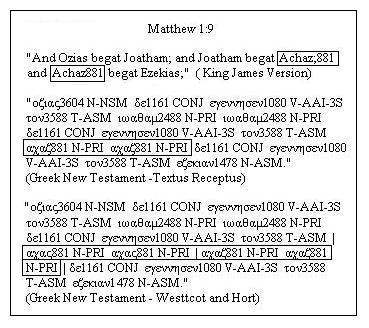 The first 17 verses of the Gospel of Matthew are a logical unit, or section, which deals with a single principal subject: "the genealogy of Christ." These initial 17 verses (the verse divisions were added in the 13th century for convenience) contain 72 Greek vocabulary words that are authenticated as God’s inspired Word through their Heptadic (#7) structure. However, this numbering structure only work's with the original Greek – "Textus Receptus" – from which the King James Bible was translated. The "Westcott and Hort Greek New Testament" (from which other Bible versions were translated) add "Achaz/Ahaz" in Matthew 1:9, thereby voiding the numerical authentication and proving it a counterfeit.
The first 17 verses of the Gospel of Matthew are a logical unit, or section, which deals with a single principal subject: "the genealogy of Christ." These initial 17 verses (the verse divisions were added in the 13th century for convenience) contain 72 Greek vocabulary words that are authenticated as God’s inspired Word through their Heptadic (#7) structure. However, this numbering structure only work's with the original Greek – "Textus Receptus" – from which the King James Bible was translated. The "Westcott and Hort Greek New Testament" (from which other Bible versions were translated) add "Achaz/Ahaz" in Matthew 1:9, thereby voiding the numerical authentication and proving it a counterfeit.
The following is a sample of the Matthew 1:1-17 "Heptadic (#7) structure" discovered by Ivan Panin:
1.) The number of words which are nouns is exactly 56, or 7 x 8.
2.) The Greek word "the" occurs most frequently in the passage: exactly 56 times, or 7 x 8.
3.) Also, the number of different forms in which the article "the" occurs is
exactly 7.
4.) There are two main sections in the passage: verse 1-11 and 12-17. In the first main section, the number of Greek vocabulary words used is 49, or 7 x 7.
5.) Of these 49 words, The number of those beginning with a vowel is 28, or 7 x 4.
6.) The number of words beginning with a consonant is 21, or 7 x 3.
7.) The total number of letters in these 49 words is exactly 266, or 7 x 38-exactly.
8.) The numbers of vowels among these 266 letters is 140, or 7 x 20.
9.) The number of consonants is 126, or 7 x 18-exactly.
10.) Of these 49 words, the number of words which occur more than once is 35, or 7 x 5.
11.) The number of words occurring only once is 14, or 7 x2.
12.) The number of words which occur in only one form is exactly 42, or 7 x 6.
13.) The number of words appearing in more than one form is also 7.
14.) The number of 49 Greek vocabulary words which are nouns is 42, or 7 x 6.
15.) The number of words which are not nouns is 7.
16.) Of the nouns, 35 are proper names, or 7 x 5.
17.) These 35 nouns are used 63 times, or 7 x 9.
18.) The number of male names is 28, or 7 x 4.
19.) These male names occur 56 times or 7 x 8.
20.) The number which are not male names is 7.
21.) Three women are mentioned-Tamar, Rahab, and Ruth. The number of Greek letters in these three names is 14, or 7 x 2.
22.) The number of compound nouns is 7.
23.) The number of Greek letters in these 7 nouns is 49, or 7 x 7.
24.) Only one city is named in this passage, Babylon, which in Greek contains exactly 7 letters.
Those are just a few of the many Heptadic (#7) structures that authenticate the King James Bible as God’s inspired Word. And to help you understand the uniqueness of these properties, try to design a genealogy – even a fictional one – that meets the following criteria:
1.) The Number of words must be divisible by 7 evenly (In each of these constraints, it is assumed that the divisions are without remainders.)
2.) The number of letters must also be divisible by 7.
3.) The number of vowels and the number of consonants must be divisible by 7.
4.) The number of words that begin with a vowel must be divisible by 7.
5.) The number of words that begin with a consonant must be divisible by 7.
6.) The number of words that occur more than once must be divisible by 7.
7.) The number of words that occur in more than one form must be divisible by 7.
8.) The number of words that occur in only one form shall be divisible by 7.
9.) The number of nouns shall be divisible by 7.
10.) Only 7 words shall not be nouns.
11.) The number of names in the genealogy shall be divisible by 7.
12.) Only 7 other kinds of nouns are permitted.
13.) The number of male names shall be divisible by 7.
14.) The number of generations shall be 21, also divisible by 7.
Gammantria
Amazing as that might be, there are even more features in the numerical structure of the words themselves. Both the Hebrew and Greek language also use the letters of the alphabet for numerical values. Therefore, any specific word – either in the Hebrew or Greek – has a numerical value of its own by adding up the values of the letters in that particular word. The study of the numerical values of words is called gammantria.
The 72 vocabulary words in Matthew 1:1-17 add up to a gammantrical value of 42,364, or 7 x 6,052. Exactl!. If one Greek letter was changed, this would not happen.
The 72 words appear in 90 forms – some appear in more than one form. The numeric value of the 90 forms is 54,075, or 7 x 7,725. Exactly!
It becomes immediately obvious that hidden below the surface are aspects of design that cannot be accidental or just coincidence. Remember, the rabbis say that "coincidence" is not a kosher word!
New Testament Example – Matthew 1:18-25
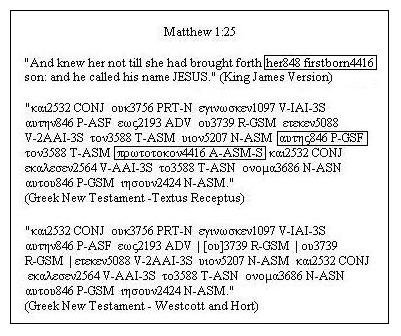 Continuing on with the first chapter of the Gospel of Matthew, let us now take a look at the pattern of sevens in verses 18-25. This is a logical unit, or section, which deals with a single principal subject: "the history of Christ birth." These 8 verses contain 77 Greek vocabulary words that are authenticated as God’s inspired Word through their Heptadic (#7) structure. And, once again, this numbering structure only work's with the original Greek – "Textus Receptus" – from which the King James Bible was translated. The "Westcott and Hort Greek NT" (from which other Bible versions were translated) omits "her firstborn" ("autos prototokos") in verse 25, thereby voiding the numerical authentication and proving it a counterfeit.
Continuing on with the first chapter of the Gospel of Matthew, let us now take a look at the pattern of sevens in verses 18-25. This is a logical unit, or section, which deals with a single principal subject: "the history of Christ birth." These 8 verses contain 77 Greek vocabulary words that are authenticated as God’s inspired Word through their Heptadic (#7) structure. And, once again, this numbering structure only work's with the original Greek – "Textus Receptus" – from which the King James Bible was translated. The "Westcott and Hort Greek NT" (from which other Bible versions were translated) omits "her firstborn" ("autos prototokos") in verse 25, thereby voiding the numerical authentication and proving it a counterfeit.
The following is a sample of the Matthew 1:18-25 "Heptadic (#7) structure" discovered by Ivan Panin:
1.) The number of words in the seven word passage is 161 (7 x 23 = 161).
2.) The number of Vocabulary words is 77 (7 x 11 = 77).
3.) Six Greek words occur only in this passage and never again in Matthew. These six Greek words contain precisely 56 letters (7 x 8 = 56).
4.) The number of distinct proper names in the passage is 7.
5.) The number of Greek letters in these seven proper names is 42 (7 x 6 = 42).
6.) The number of words spoken by the angel to Joseph is 28 (7 x 4 = 28).
7.) The number of Greek forms of words used in this passage is 161 (7 x 23 = 161).
8.) The number of Greek forms of words in the angel's speech is 35 (7 x 5 = 35).
9.) The number of letters in the angel's 35 forms of words is 168 (7 x 24 = 168).
Other Implications
There are words in Matthew’s passage just described that occur nowhere else in the New Testament. They occur 42 times (7 x 6) and have 126 letters (7 x 18). How was this organized?
Even if Matthew contrived this characteristic into his Gospel, how could he have known that these specific words – whose sole characteristic is that they are found nowhere else in the New Testament – were not going to be used by the other writers? Unless we assume the absurd hypothesis that he had an agreement with them, he must have had the rest of the New Testament before him when he wrote his book. The Gospel of Matthew, then, must have been written last.
It so happens, however, that the Gospel of Mark exhibits the same phenomenon. It can be demonstrated that it would have had to be written "last." The same phenomenon is also found in Luke, John, James, Peter, Jude and Paul. Each would have had to write after the other in order to contrive the vocabulary frequencies! Therefore, you can demonstrate that each of the New Testament books had to have been "written last."
There is no human explanation for this incredible and precise structure. It has all been supernaturally designed.
Old Testament Example – Genesis 1:1
"In the beginning God created the heaven and the earth" (Genesis 1:1 KJV)
In the Hebrew text of Genesis 1:1, Ivan Panin carefully examined and discovered an incredible phenomenon of multiples of 7 that could not be explained by chance. Genesis 1:1 was composed of seven Hebrew words containing a total of 28 letters. In this first verse of the Holy Bible, Panin discovered 30 separate codes involving the number 7, with the following being a partial list thereof:
1.) The number of Hebrew words equals 7.
2.) The number of letters equals 28 (7 x 4 = 28).
3.) The first three Hebrew words translated "In the beginning God created" contain 14 letters (7 x 2 = 14).
4.) The last four Hebrew words "the heaven and the earth" have 14 letters (7 x 2 = 14).
5.) The fourth and fifth words have 7 letters.
6.) The sixth and seventh words have 7 letters.
7.) The three key words: God, heaven and earth have 14 letters (7 x 2 = 14).
8.) The number of letters in the four remaining words is also 14 (7 x 2 = 14).
9.) The shortest word in the verse is the middle word with 7 letters.
10.) The Hebrew numeric value of the first, middle and last letters is 133 (7 x 19 = 133).
11.) The Hebrew numeric value of the first and last letters of all seven words is 1393 (7 x 199 = 1393).
When professors on the mathematics faculty at Harvard University were presented with this biblical phenomenon they naturally attempted to disprove its significance as a proof of divine authorship. However, after valiant efforts these professors were unable to duplicate this incredible mathematical phenomenon. The Harvard scientists used the English language and artificially assigned numeric values to the English alphabet. They had a potential vocabulary of over 400,000 available English words to choose from to construct a sentence about any topic they chose. Compare this to the limitations of word choices in the biblical Hebrew language that has only forty-five hundred available word choices that the writers of the Old Testament could use. Despite their advanced mathematical abilities and access to computers the mathematicians were unable to come close to incorporating 30 mathematical multiples of 7 as found in the Hebrew words of Genesis 1:1.
The number "seven" permeates the totality of Scripture because the number speaks of God's divine perfection and perfect order. The actual number 7 appears 287 times in the Old Testament (7 x 41 = 287) while the word "seventh" occurs 98 times (7 x 14 = 98). The word "seven-fold" appears seven times. In addition, the word "seventy" is used 56 times (7 x 8 = 56).
Ivan Panin discovered literally thousands of such mathematical patterns underlying all of the books of the Old Testament before his death in 1942. Panin and others have examined other Hebrew literature and have attempted to find such mathematical patterns, but they are not found anywhere outside the Bible.
Conclusion
Numerous authorities have examined this phenomenal discovery by Panin and the figures have been verified. In total, Panin accumulated over forty thousand pages of detailed calculations covering most of the text of the Bible before his death. These amazing patterns appear in the vocabulary, grammatical forms, parts of speech, and particular forms of words. They occur throughout the whole text of the Bible containing 31,173 verses. When you consider the amazing details of this mathematical phenomenon you realize that the change of a single letter or word in the original languages of Hebrew or Greek would destroy the pattern. Now we can understand why Jesus Christ declared that the smallest letter and grammatical mark of the Scriptures was persevered by God's Hand: "For verily I say unto you, Till heaven and earth pass, one jot or one tittle shall in no wise pass from the law, till all be fulfilled" (Matthew 5:18 KJV).
And by the way, the crucifixion of Jesus took place at Golgotha, elevation 777 meters above sea level. What an awesome God we serve!

 The first 17 verses of the Gospel of Matthew are a logical unit, or section, which deals with a single principal subject: "the genealogy of Christ." These initial 17 verses (the verse divisions were added in the 13th century for convenience) contain 72 Greek vocabulary words that are authenticated as God’s inspired Word through their Heptadic (#7) structure. However, this numbering structure only work's with the original Greek – "Textus Receptus" – from which the King James Bible was translated. The "Westcott and Hort Greek New Testament" (from which other Bible versions were translated) add "Achaz/Ahaz" in Matthew 1:9, thereby voiding the numerical authentication and proving it a counterfeit.
The first 17 verses of the Gospel of Matthew are a logical unit, or section, which deals with a single principal subject: "the genealogy of Christ." These initial 17 verses (the verse divisions were added in the 13th century for convenience) contain 72 Greek vocabulary words that are authenticated as God’s inspired Word through their Heptadic (#7) structure. However, this numbering structure only work's with the original Greek – "Textus Receptus" – from which the King James Bible was translated. The "Westcott and Hort Greek New Testament" (from which other Bible versions were translated) add "Achaz/Ahaz" in Matthew 1:9, thereby voiding the numerical authentication and proving it a counterfeit. Continuing on with the first chapter of the Gospel of Matthew, let us now take a look at the pattern of sevens in verses 18-25. This is a logical unit, or section, which deals with a single principal subject: "the history of Christ birth." These 8 verses contain 77 Greek vocabulary words that are authenticated as God’s inspired Word through their Heptadic (#7) structure. And, once again, this numbering structure only work's with the original Greek – "Textus Receptus" – from which the King James Bible was translated. The "Westcott and Hort Greek NT" (from which other Bible versions were translated) omits "her firstborn" ("autos prototokos") in verse 25, thereby voiding the numerical authentication and proving it a counterfeit.
Continuing on with the first chapter of the Gospel of Matthew, let us now take a look at the pattern of sevens in verses 18-25. This is a logical unit, or section, which deals with a single principal subject: "the history of Christ birth." These 8 verses contain 77 Greek vocabulary words that are authenticated as God’s inspired Word through their Heptadic (#7) structure. And, once again, this numbering structure only work's with the original Greek – "Textus Receptus" – from which the King James Bible was translated. The "Westcott and Hort Greek NT" (from which other Bible versions were translated) omits "her firstborn" ("autos prototokos") in verse 25, thereby voiding the numerical authentication and proving it a counterfeit.